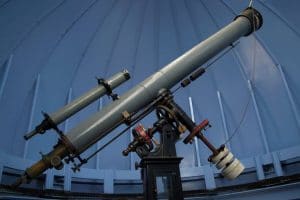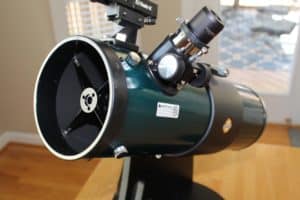Looking for the best telescope under $1000? That’s an excellent price point to find good value – solid capabilities without breaking the bank. In this post, we share our opinion of 7 best value picks for a telescope under 1000 dollars. You’ll definitely want to check these out before making your next purchase, along with our recommendations for next-level dobsonian, refractor and computerized telescopes.
See also:
(Before we begin, please note that product pricing, price categories and availability are accurate as of the date of this post, but are subject to change. This post includes the author’s opinion, based on research and experience, of the “best” or “top” telescopes in this category; the opinions of others may vary.)
Our Take on the Best Telescope Under $1000 (Top 7 Picks)
1. Celestron NexStar 4SE Computerized Telescope
Our #1 pick for the best telescope under $1000 is the Celestron NexStar 4SE (in fact, the entire Celestron NexStar family is fantastic, as we cover here). The Celestron NexStar 4SE is a popular, computerized telescope that is one of the best telescope under 1000 dollars. It provides excellent optical performance with a 4″ primary mirror, and an easy-to-use computerized mount (i.e. it can automatically find and track 40,000 astronomical objects based on your location). The StarBright XLT optical coating enhaces light transmission for brighter images. The NexStar SE model also comes in a range of apertures and focal lengths, each at a different price point. The NexStar 4SE is one of the more affordable of the bunch that also includes NexStar 5SE, 6SE and 8SE. With the great optics, easy-use computerized features and portability, this family of telescopes is one of the best all-around.
Scorecard – Celestron NexStar 4SE Computerized Telescope
| Category | Our Verdict | Why? |
|---|---|---|
| Skill Level | Beginner to Intermediate | Advanced computerized capabilities make it easier to operate |
| Quality | 5 out of 5 | Great warranty and solid component quality |
| Ease of Use | 5 out of 5 | Automatically locates and tracks objects |
| Power & Clarity | 4 out of 5 | Moderate aperture, good magnification; higher-end models available |
| Control | 4 out of 5 | Computerized AZ mount |
| Portability | 5 out of 5 | Light-weight and easy to move |
| Accessories | 3 out of 5 | Basics included but there are a few additional things you'll probably want to add |
| Overall Value | 5 out of 5 | Top value under $1000 from the great NexStar SE line |
Why We Like It
The NexStar 4SE is a great starter telescope, providing good value from a reliable brand that offers a 2-year warranty. You can set the NexStar 4SE up quickly in the backyard, easily pack and port it around. Coming in at 21 lbs, it’s light weight enough for travel / camping. It provides great images at the price point with its 53x magnification and 102mm aperture. The NexStar 4SE is even capable of astrophotography with the right accessories. Notably, the SkyAlign software can find 40,000 objects in the night sky and track them for you. This is a fantastic feature for beginners and more advanced amateurs.
Pros
- Best value for money in our opinion
- User-friendly design, fully computerized “GoTo” capability making it easy to track and find objects
- Simple setup; great portability for the price point
- 2-year Celestron warranty
- Good visuals, capable of beginner astrophotography
Cons
- We wish it came with more eyepiece options and GPS
Recommended Accessories
- If you want to connect your DSLR camera (Canon or Nikon), Celestron sells the appropriate T-adapter and T-rings here: See it on Amazon.com
- Celestron carrying case for NexStar optical tubes: See it on Amazon.com
2. Orion SkyQuest XT8 Plus Dobsonian Reflector Telescope
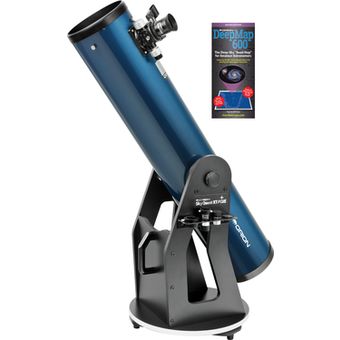
Image Credit: Orion (Used with Permission)
Coming in at #2 on our list, the Orion SkyQuest XT8 Plus Dobsonian Reflector Telescope offers great bang for the buck to become, in our view, one of the best telescope under 1000 dollars. Orion has upgraded the classic SkyQuest XT8 in this Plus-version with a number of enhanced features and accessories. The scope looks fantastic in metallic blue, and the upgrades pack a real value punch of great image quality of planets and nebulae without breaking the bank. Dobsonians are not the most portable telescopes, but Orion has made efforts with the upgrades to lighten the weight (now around 42 lbs) and make for easy assembly / disassembly to transport the scope as needed.
Scorecard – Orion SkyQuest XT8 Plus Dobsonian Reflector Telescope
| Category | Our Verdict | Why? |
|---|---|---|
| Skill Level | Beginner to Intermediate | Not a true beginner telescope |
| Quality | 5 out of 5 | Great component quality |
| Ease of Use | 3 out of 5 | Requires some skill/practice; collimation required |
| Power & Clarity | 5 out of 5 | Excellent images and lense options |
| Control | 4 out of 5 | Dobsonian mount reqires some skill/practice |
| Portability | 2 out of 5 | Transportable, but not portable |
| Accessories | 5 out of 5 | Multiple, high-quality accessories |
| Overall Value | 5 out of 5 | Great value for excellent images |
Why We Like It
We love this telescope. If you are looking at Dobsonians telescopes for under $1000, then this is the one for you. With a Dobsonian, you trade off portability and a bit of ease-of-use for better viewing and images; but for those prioritizing image quality, the SkyQuest XT8 Plus is the one to consider.
The XT8 Plus also comes with some great features and accessories. These include (1) a 28mm DeepView eyepiece, which widens the field of view, (2) a 1.25″ 10mm Sirius Plossl eyepiece (120x), (3) a 2″ shorty Barlow, for even more zoom (240x when coupled with the 10mm), (4) easy finder scope, (5) dual-speed Crayford focuser for precise views, (6) thumb knobs for secondary mirror adjustments to help with collimation, and (7) the DeepMap 600, providing a map of the sky with interesting objects.
(If you like this telescope, you might also want to check out our full review of the Orion SkyQuest XT10, big brother to the XT8. The XT10 has a Plus-version available as well.)
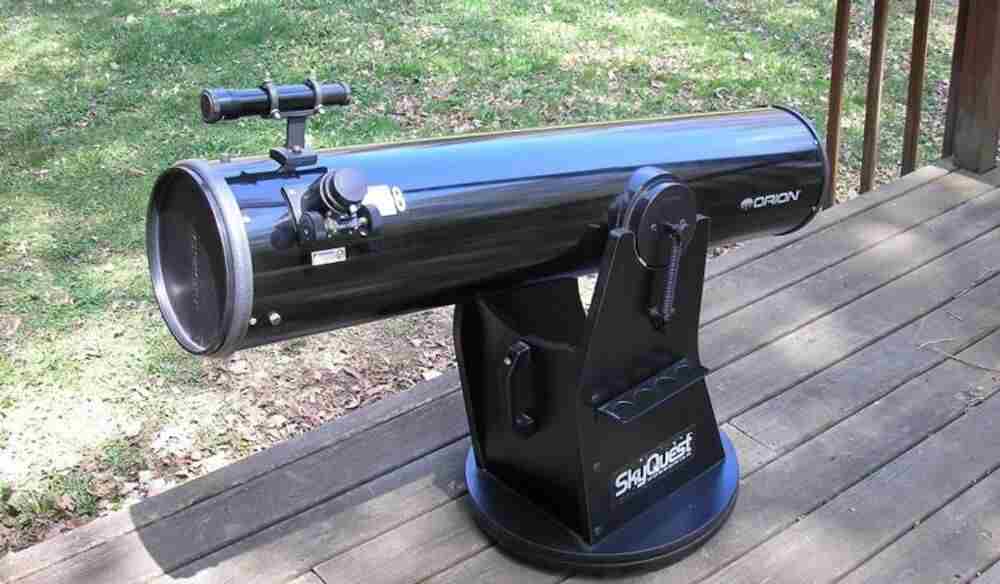
Pros
- Excellent image quality and visuals; best choice, in our opinion, for those who prioritize visuals
- Includes fantastic accessories and eyepieces
Cons
- Less portable than others on this list
- As a reflector, will require maintenance / collimation
3. Celestron NexStar 127SLT Computerized Telescope
Also very highly rated and our top pick for beginners for the best telescope under 1000 dollars is the Celestron NexStar 127 SLT, a Maksutov-Cassegrain telescope with computerized Star Locating Technology (i.e. the “SLT”). The telescope includes a database of more than 40,000 stars, galaxies and nebulae, which it can automatically locate for you after orientating itself based your location. You can use the hand-held control to choose specific objects that you would like to see, or have the telescope take you on a tour of the night sky. This is an amazing telescope for a great price that’s perfect for viewing from cities or suburban areas.
Scorecard – Celestron NexStar 127SLT Computerized Telescope
| Category | Our Verdict | Why? |
|---|---|---|
| Skill Level | Beginner to Intermediate | Advanced computerized capabilities |
| Quality | 5 out of 5 | Great component quality |
| Ease of Use | 5 out of 5 | Automatically locates and tracks objects |
| Power & Clarity | 4 out of 5 | Good aperture, good magnification |
| Control | 5 out of 5 | Computerized mount; Star Locator tech. |
| Portability | 4 out of 5 | Light-weight and easy to move |
| Accessories | 3 out of 5 | Basics included but there are a few additional things you'll probably want to add |
| Overall Value | 4 out of 5 | Great value; great first telescope |
Why We Like It
The NexStar 127SLT is, in our view, a fantastic telescope that, like its SE cousins, provides good value from a reliable brand that offers a 2-year warranty. At 18 lbs, the telescope is very portable. The controls and SLT automation make it extremely easy to use (alignment can be easily done via GPS coordinates); and it provides great images at the price point with its 60x and 167x magnification, 127mm aperture and 1500mm focal length. The field of view is narrower than the 130SLT version below, but the telescope provides great planetary views and is appropriately sized for its mount.
Pros
- Extremely easy to track and find objects
- Simple setup; great portability
- Good visuals within a narrow field
Cons
- Best used with power tank or cable
4. Orion 9005 AstroView 120ST Equatorial Refractor Telescope
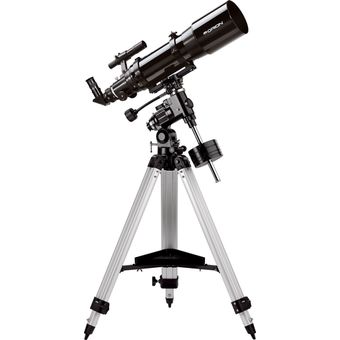
Image Credit: Orion (Used with Permission)
The Orion 9005 AstroView is not only a one of the best telescope under 1000 dollars typically, but also our highest rated equatorial refractor telescope under $1000. It’s a grab-and-go scope with a 120mm aperture, 600mm focal length refractor with premium achromatic optics – providing high-contrast, high-powered images with a wide field, perfect for great views of the moon and the big, deep sky objects. The manual equatorial mount is super sturdy, heavy, and precise for tracking objects. Overall quality is excellent – from the optics, to the mount, to the accessories.
Scorecard – Orion 9005 AstroView 120ST Equatorial Refractor Telescope
| Category | Our Verdict | Why? |
|---|---|---|
| Skill Level | Beginner to Intermediate | Not a true beginner telescope |
| Quality | 4 out of 5 | Great component quality |
| Ease of Use | 3 out of 5 | Requires some skill/practice; manual focus |
| Power & Clarity | 4 out of 5 | Wide aperture, high-contrast images |
| Control | 5 out of 5 | Precise equatorial tracking mount with internal polar alignment scope |
| Portability | 3 out of 5 | Mount is heavy |
| Accessories | 4 out of 5 | High-quality accessories |
| Overall Value | 4 out of 5 | Great value for large deep sky objects |
Why We Like It
We love the quality and sleek look of the Orion 9005. The visuals are great (multi-coated, with a well-baffled optical tube for high-contrast), capturing a wide view of the sky. This is the kind of telescope that you will want to view those larger deep sky objects like the Orion nebula or Andromeda galaxy. For planetary viewing, the scope works well with a Barlow lens (sold separately). The 36lb telescope and mount are less portable than some, but the setup is super sturdy and still able to be thrown in the car for camping or a trip to out of the city. Orion has put some effort into the AstroView mount to make for quick disassembly or swapping out scopes. (The equatorial mount can also be upgraded with the EQ-3M electronic motorized drive for automatic tracking.)
The scope comes with a great accessory package (typical for Orion) that includes a sturdy adjustable-height tripod, Orion’s standard Starry Night astronomy software, as well as two Sirius Plossl 1.25″ eyepieces eyepieces (25mm and 10mm) allowing for 24x and 60x magnification. (Note: If you want higher magnification or planetary viewing, we recommend upgrading with a 2x or 3x Barlow lens.)
Pros
- Great build quality — sleek appearance and sturdy mount
- Good visuals for large object viewing
- Transportable and easy to disassemble
Cons
- Recommend buying a carrying case
- Equatorial mount can be more difficult to use
- Only 1-year warranty
- Need additional lenses for planetary viewing
Recommended Accessories
We would recommend purchasing: a 2x Barlow lens (See it on Amazon.com) or a 3x Barlow lens (See it on Amazon.com) with the Orion 9005.
5. Celestron NexStar 130SLT Computerized Telescope
Another highly rated Celestron among our top five picks for the best telescope under 1000 dollars, the Celestron NexStar 130SLT offers a Newtonian Reflector with the same great SLT option as the NexStar127SLT above. The 130SLT provides a wider field of view compared with the 127SLT, and would be preferable if you were viewing large clusters and nebulae under a very dark sky. The optics permit you to see Saturn’s rings, Jupiter’s cloud bands, the Moon, & brighter deep sky objects.
The telescope includes a database of more than 40,000 stars, galaxies and nebulae, which it can automatically locate for you after orientating itself based your location. You can use the hand-held control to choose specific objects that you would like to see, or have the telescope take you on a tour of the night sky. This is a great option if you’re looking for a “go-to” telescope with a wider field of view than the 127SLT.
Scorecard – Celestron NexStar 130SLT Computerized Telescope
| Category | Our Verdict | Why? |
|---|---|---|
| Skill Level | Beginner to Intermediate | Advanced computerized capabilities |
| Quality | 5 out of 5 | Great component quality |
| Ease of Use | 5 out of 5 | Automatically locates and tracks objects |
| Power & Clarity | 4 out of 5 | Good aperture, good magnification |
| Control | 4 out of 5 | Computerized mount; Star Locator tech. Scope can be a bit much for the mount. |
| Portability | 4 out of 5 | Light-weight and easy to move |
| Accessories | 3 out of 5 | Basics included but there are a few additional things you'll probably want to add |
| Overall Value | 4 out of 5 | Great value in a go-to scope |
Why We Like It
Like the Nexstar 127SLT above, the NexStar 130SLT provides good value from a reliable brand that offers a 2-year warranty. At 18 lbs, the telescope is definitely portable, and like the 127SLT, the controls and automation of the 130SLT make it extremely easy to use (alignment can be easily done via GPS coordinates). The telescope can be a bit much for the mount, but the 130SLT provides great images at the price point with its 130mm aperture, 650mm focal length, and 26x and 72x magnification.
Pros
- Extremely easy to track and find objects due to SLT
- Simple setup; great portability
- Good visuals; wider field of view than the NexStar 127SLT
- 2-year Celestron warranty
Cons
- Best used with power tank or cable
- A bit oversized for the mount
Recommended Accessories
You may want to pick up a Celestron power tank with your NexStar 130SLT: See it on Amazon.com
6. Orion 27191 StarBlast 6i IntelliScope Reflector Telescope

Image Credit: Orion (Used with Permission)
Looking for a tabletop scope to avoid hassles with a mount? The Orion 27191 StarBlast 6i Intelliscope represents, in our view, one of the best telescope under 1000 dollars with tabletop form factor. The Orion 27191 provides a computerized, PushTo experience, helping beginner-to-intermediate astronomer easily locate deep sky objects. (With a “PushTo” telescope, unlike a “GoTo”, you still move the telescope, but the computer helps you know where to point it.) With its sizeable 150mm aperture, 750mm focal length and 21x magnification, you can enjoy sharp, contrast-rich views of brighter nebulae, galaxies, and star clusters, as well as planets, including Jupiter’s cloud bands. The Orion 27191 is easy to use right out of the box, and weighing 23.5 lbs, definitely transportable (if not a scope you want for general portability).
Scorecard – Orion 27191 StarBlast 6i IntelliScope Telescope Reflector Telescope
| Category | Our Verdict | Why? |
|---|---|---|
| Skill Level | Beginner to Intermediate | IntelliScope "push-to" capability helps you locate objects in the sky |
| Quality | 4 out of 5 | Sturdy component quality |
| Ease of Use | 4 out of 5 | Easy to use tabletop design; requires collimation |
| Power & Clarity | 4 out of 5 | Bright images with 6" primary mirror |
| Control | 4 out of 5 | Easy to point and move; requires manual tracking of objects with AZ mount |
| Portability | 4 out of 5 | Super compact and easy to setup for a 6" telescope |
| Accessories | 4 out of 5 | Good accessories from Orion |
| Overall Value | 4 out of 5 | Great value for tabletop design with computerized capability |
Why We Like It
The Orion 27191 is a sturdy, easy-to-use tabletop telescope under $1000, with computerized push-to capability that makes it an excellent option for at home viewing. The images are great, and the Orion 27191’s optics really excel at wide field, larger object viewing. Finding deep sky objects can be difficult, and that’s where the computer-assisted capability of this and other computerized scopes really comes in handy. It would be useful to combine this telescope with a Barlow lens for a bit more zoom capability. For someone looking to avoid hassles with tripods and mounts, while also getting excellent images, this is a way to go. Orion always (in our experience) includes quality accessories with their scopes, and this is no exception. The Orion 27191 comes with two Sirius Plossl 1.25″ eyepieces (25mm & 10mm ), an EZ Finder II aiming device, eyepiece rack and Starry Night software.
Pros
- Easy to find objects using computer-assisted capability and Starry Night software
- Straightforward setup with tabletop form factor
- Good visuals for a wider field of view
- Sturdy base and design
Cons
- As a tabletop, less portable than some telescopes
- Best combined with a Barlow lens for more zoom capability
Recommended Accessories
We would recommend purchasing a 2x Barlow lens with the Orion 27191: See it on Amazon.com
7. Orion 8297 8-Inch f/3.9 Newtonian Astrograph Reflector Telescope
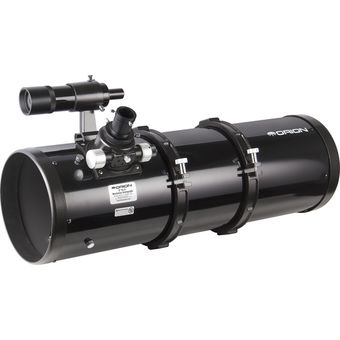
Image Credit: Orion (Used with Permission)
Buy the Orion 8297 Newtonian Astrograph Reflector Telescope if you are an intermediate or even experienced beginner astronomer and all about image quality and/or astrophotography. The views / images are fantastic. The Orion 8297 offers a very large aperture at 203mm, with an f3.9 focal ratio, and its mirrors have enhanced reflectivity (94%) aluminum coatings with a protective quartz overcoat. Orion has also included a 2-inch dual-speed focuser, nine internal baffles and flat black interior with the 8297. All of this helps the Orion 8297 provide absolutely amazing, high contrast images, perfect for astrophotography, as well as just breathtaking enjoyment. The build quality is very solid as well, and Orion offers great service as always. For those most interested in image quality, the Orion 8297 is, in our view, one of the best telescope under 1000 dollars.
Scorecard – Orion 8297 8-Inch f/3.9 Newtonian Astrograph Reflector Telescope
| Category | Our Verdict | Why? |
|---|---|---|
| Skill Level | Intermediate | Typical Newtonian issues; no accessories |
| Quality | 5 out of 5 | Great component quality |
| Ease of Use | 3 out of 5 | Collimation required |
| Power & Clarity | 5 out of 5 | Excellent aperture and magnification; great images |
| Control | 4 out of 5 | Dual speed focuser; mount will incluence |
| Portability | 3 out of 5 | Less than ideal portability |
| Accessories | 2 out of 5 | Scope only |
| Overall Value | 4 out of 5 | High quality images and viewing experience |
Why We Like It
The Orion 8297 excels for its visuals and in particular its astrophotography. The focal ratio and design allow for shorter exposure times due to the amount of light the scope can take in. The mirror placement and sizing also address common problems experienced by astrophotographers in getting light to DSLR sensors when using Newtonian reflectors. Given the affordable price point, the trade-offs (you have to expect them) with the scope go to ease-of-use and accessories. Mounts and lenses come separately; and like with all Newtonians, you will likely want a collimation laser and coma corrector to go along with your purchase.
Pros
- Amazing astrophotography and excellent viewing images
- Great Orion service
- High-quality, thoughtful design
Cons
- Mounts, lens, collimation laser and coma corrector all come separtely
- Not very portable or beginner friendly
Recommended Accessories
Click here to expandYou’ll likely want to buy a computerized equatorial mount separately, collimation laser and coma corrector together with the telescope. Some recommended options include:
- Orion’s Atlas EQ-G: See it on Telescope.com
- Svbony Red Laser Collimator: See it on Amazon.com
Honorable Mention: Orion StarSeeker IV 130mm GoTo Reflector Telescope Kit

Image Credit: Orion (Used with Permission)
Our final pick for one of the best telescope under $1000 packs value. The Orion StarSeeker IV is a great computerized, go-to telescope under $1000 that offers many upgrades over its predecessors. The StarSeeker IV’s 130mm aperture, 650 mm focal length and parabolic reflecting optics provide bright, wide-field views. The optics are sufficient to see moon and planets (e.g., rings of Saturn and Jupiter) as well as Messier and other deep sky objects. The included tripod is well built and provides sturdy support.
Orion has improved the dual-encoder, go-to capability to keep track of post-alignment manual movements, making for much easier use. This saves on battery life as the user can now limit the go-to function to final adjustments. Finally, as promised, this Orion StarSeeker IV comes with a go-to hand controller, 23mm (28.2x) and 10mm (65x) wide-field 60-degree eyepieces, easy-finder sight, power-doubling 2x shorty Barlow, moon filter, a handy AC-to-DC adapter, and Orion’s DeepMap 600 and MoonMap 260. We told you it packed a lot of value in there!
Scorecard – Orion StarSeeker IV 130mm GoTo Reflector Telescope
| Category | Our Verdict | Why? |
|---|---|---|
| Skill Level | Beginner | Computerized capabilities |
| Quality | 4 out of 5 | Good component quality |
| Ease of Use | 5 out of 5 | Automatically locates and tracks objects |
| Power & Clarity | 4 out of 5 | Good aperture; bright, wide views |
| Control | 4 out of 5 | Computerized mount with Go-To capability |
| Portability | 3 out of 5 | At 21lbs, not the most portable |
| Accessories | 5 out of 5 | Superb set of accessories |
| Overall Value | 4 out of 5 | Exceptional value pack |
Why We Like It
The overall value of this package is superb. You get an easy-to-use, high quality telescope and a lot of accessories for your money. This kit is an excellent starting place for a beginner just starting out or an intermediate user looking to re-stock. The scope itself has good optics, capable of viewing planets and even deep space objects. The accessory lenses included in the kit give you a lot of variation to explore. The moon filter and MoonMap 260 make it easy to study craters and landing sites on our lunar neighbor. Orion’s go-to capability, including the improvements to the dual-encoder, also make this a very easy-to-use, reasonably portable telescope. We love this package as a holiday gift or for personal use; it’s really an unbeatable value pack.
Pros
- Excellent go-to capability
- Superb package of accessories
- Quality product
Cons
- Not ideal for astrophotography
Frequently Asked Questions (FAQ) for Best Telescope Under $1000
Which telescope is right for me?
Trying to find the best telescope under $1000 is like buying a car — the “right” choice highly depends on your circumstances and how you’ll use it. When you’re looking for the best telescope under 1000 dollars / best telescope under $1000, you’re looking to make a not insignificant purchase, and so you want to make sure you (1) get a good quality product and (2) find something that you will be happy to use repeatedly.
We’re confident that our recommendations for the best $1000 telescope above put you squarely in the “quality product” category for the best telescope under $1000. We’ve focused on strong brands, and the individual telescopes not only meet our critical expertise but also have very good reviews from others.
That brings us to point (2): how do you plan to use the scope / what are your priorities? We would encourage you to think about a couple key questions to assess what matters most to you when choosing the best $1000 telescope. These include:
1. What kind of viewing conditions do you anticipate?
For viewing either larger, faint objects like deep sky nebulae, clusters and galaxies, or smaller, brighter objects like planets, the aperture of the telescope is probably the most important feature. Magnification can help, particularly with planetary viewing, but pay the most attention to aperture. The larger the aperture, the more light can enter the scope to make those faint objects brighter and those small objects more visible.
The type of telescope (reflector vs. refractor) can also impact viewing clarity. Reflector scopes tend to have secondary mirrors that reduce light gathering capabilities, while refractors can provide bright images of those fainter objects but tend to break apart blue and red light leaving a halo-like effect on smaller objects unless you buy an apochromatic lens.
BUT if you expect to be using the telescope from a heavily light-polluted or cloudy area, you could have a situation where no amount of aperture really helps you in viewing faint objects – the light just won’t get through.
For smaller objects, atmospheric stability (or instability) also matters. If you’re viewing from a location with a lot of atmospheric shimmer, you may not get the return on investment with the larger scopes. We do not recommend most amateur astronomers go above 8″-12″ in diameter because the atmosphere will never get still enough to take advantage of the aperture.
2. How much ease-of-use do you require (i.e. portability, ease-of-setup, ease-of-operation and maintenance)?
While some of the larger telescopes under $1000 (i.e. larger aperture) help image clarity, they lose ground on portability and often ease-of-use. This is where more compact, computerized telescopes under $1000 like the NexStar SE series shine. They will take a few minutes to align while setting up, but are much quicker to setup, must easier to use, require less maintenance and can be totted around much more easily than some of the larger refractors.
Smaller telescopes under $1000 also need less time to reach cooler temperatures than larger ones; cooler temperature of a scope improves image quality.
Think through these factors to determine how you expect to use the scope. If you do not need good portability and want to emphasize aperture, a dobsonian may be a great option. If you want to explore the sky organically from a remote countryside, you may be excited about a large, manual refractor.
By contrast, those who value a quick tour of the sky, like jumping from object to object and/or may be viewing from areas where the night sky is less visible may prefer a computerized, go-to capability.
3. With these points in mind, here are some specific thoughts on the options available for the best telescope under $1000:
If you want a well-rounded, full package telescope — portable, good images and easy-to-use go-to features, we recommend you buy a telescope under $1000 in the NexStar SE family (see our #1 pick above, as well as the NexStar 5SE, NexStar 6SE and (with the right discounts) NexStar 8SE models). These may take a little more practice to setup, but the benefits include easy-to-locate deep sky objects, precision control and smooth tracking of objects, great images, and a solid intro astrophotography option. You’ll definitely find this investment to be worthwhile.
For the backyard or dark-sky location amateur or intermediate astronomer, we recommend an Orion SkyQuest XT8 Plus (our option #2 above). Dobsonians are (in our opinion) the most cost-effective way to get large aperture (for fantastic views) combined with an affordable, practical, transportable, and straight-forward user experience. It’s a great design if you want to spend your viewing sessions taking in the beauty of the sky and learning how to navigate by star-hopping.
If you are looking to really get into astrophotography, we would recommend the Orion 8297 Newtownian Astrograph (our #7 option above). The telescope will provide exellent images for the price, and provide a great use experience with the right accessories.
What’s the Difference Between the “Equatorial” or “EQ” and “Alt-Azimuth” or “AZ” Models?
The EQ or Equatorial mounts take some practice and skill, but ultimately will provide finer control and enable you to track objects smoothly as the earth’s rotation causes them to drift across the sky. AZ or Alt-Azimuth mounts are a bit easier for the beginner to operate but do not provide as much control as the Equatorial versions.
Can I Take Photographs Through A Telescope?
Yes, indeed, you can. This is known as “astrophotography” and it requires a smartphone or high-definition camera, plus the right adapter and methodology for your telescope. Check out our guide to the best astrophotography telescopes.
(Also, if you liked this article, please share it using the social media buttons below!)
Feature Image Credit: m-gucci / iStock





